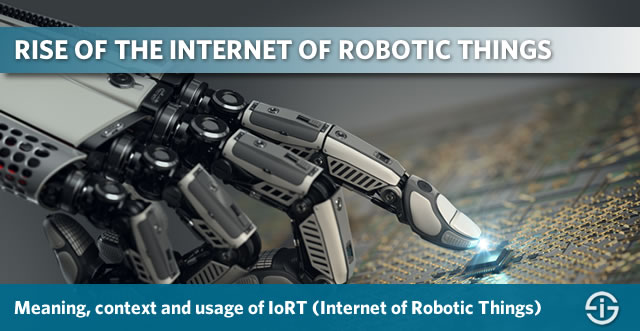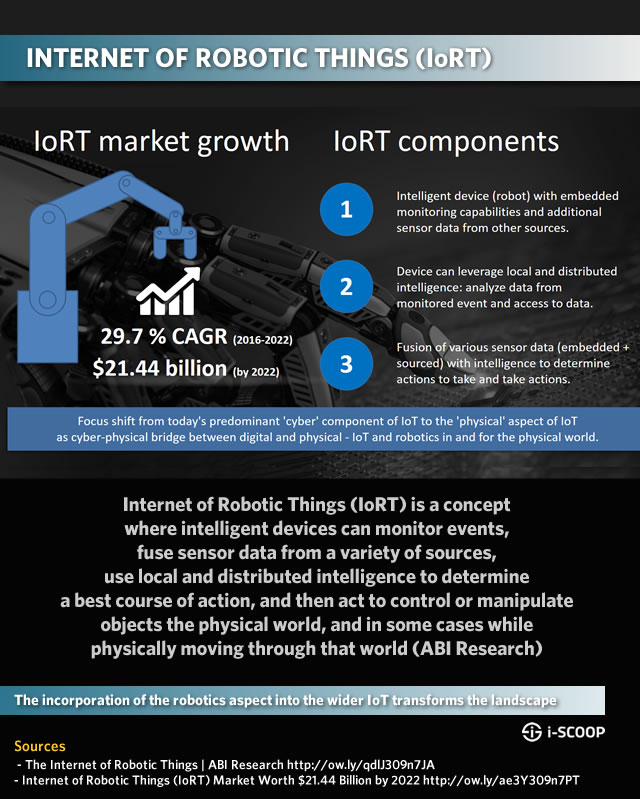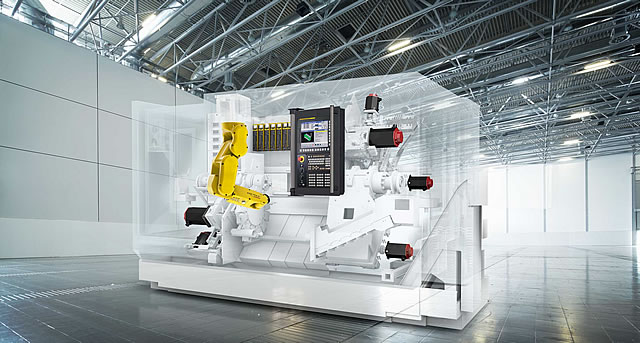An overview of the growing market of the Internet of Robotic Things (IoRT): where does it come from, what does it mean, where does it stand and where is it heading.
If you reduce the IoT to its essence, you see uniquely identifiable IP objects which are equipped/embedded with sensing possibilities (sensors), tags and possibly actuators on the edge.
These IoT devices communicate and transmit data to other devices and to hubs and next to platforms where the data is analyzed (if not done at the edge through fog computing) and feeds applications, and systems of insight to take decisions, visualize issues and patterns, steer processes and so forth. So, there is data gathering, analytics, communication, the cloud, middleware (IoT platforms) and applications, leveraging the data from somewhat passive sensors.

Internet of Things and robotics: the first stage
In this simple depiction of the Internet of Things you notice that we are essentially in a reality of machine to machine (M2M, communication between devices) and a reality of information-gathering systems that include ‘things’ in an ecosystem whereby data is leveraged to drive insights and actionable outcomes (and whereby M2M is a subset of the Internet of Things).
These outcomes are the many IoT use cases: setting up a smart parking system, developing a precision farming project, monitoring (and reducing) air pollution and, in the Industrial Internet of Things, use cases such as predictive maintenance or enhancing the safety of workers, for instance in manufacturing or in mining as we explained in a case.
With the latter use cases, typically part of what is called the Industrial Internet or Industry 4.0, we come in industries where the physical component is very high and there is a large Operational Technology (OT) aspect.
One of the main ‘physical’ technology components in the manufacturing industry concerns robotics, in this context industrial robots. Obviously, robotics is about more than just industrial robots. We see a growth in various segments of the broader robotics ecosystem, including personal robots, but it’s clear that robots in industrial markets represent a big chunk.
There are already many links between robotics and the Internet of Things. We’ve explained how, thanks to connecting robots through the Internet of Things, ABB Robotics could, among others move towards predictive maintenance and entirely new services. However, in such cases there remains an important human element and, in essence, we are still talking about applications in the scope of leveraging sensor-based data to achieve specific outcomes based on this real-time data.
Taking the bridging of physical and digital a step further: the Internet of Robotic Things
The ‘promise’ of the Internet of Things also has been – and is – about bridging physical and digital worlds. Take retail for example where the IoT plays a role in doing just that.
In Industry 4.0 or the Industrial Internet, this bridging of physical and digital worlds is referred to as cyber physical systems (even if there is a bit more to it).
All by all this bridging is still relatively ‘easy’, even if it opens up new worlds of possibilities as we still discover. However, what if we took it a step further and really integrated digital and physical in robots that have the possibility to take autonomous decisions within a specific context and scope, as they are not just embedded with Internet of Things components but also can analyze the data and act upon them.
This is where the Internet of Robotic Things or IoRT comes in. Before you think ‘what, another acronym and term on top of IoT, IIoT, IoE and so forth‘: the concept isn’t new. ABI Research came up with it in 2014. The thing is that in 2016 we’ve seen the first real initiatives pop up and that you’ll increasingly hear about it as the Internet of Robotic Things is happening, maturing and becoming a reality.
The Internet of Robotic Things market: over $20 billion by 2022
Let’s put some numbers on the Internet of Robotic Things market. A report, released end 2016, by Markets and Markets predicts that the Internet of Robotic Things market will be worth approximately $21.44 billion by 2022.
This would mean a Compound Annual Growth Rate (CAGR) for the IoRT market of 29.7 percent until 2022. To put this into perspective: IoT spending in the utilities market (mainly smart grid) in 2016 totaled $69 billion. Although 2022 is still far away it gives you an idea of the IoRT market’s importance if the forecasts are more or less correct.

This is even more impressive if we know that the Internet of Robotic Things, although being very real, is still in its early days.
The Internet of Robotic Things defined and explained
Now, let’s take a closer look at the Internet of Robotic Things. The main difference with the Internet of Things as we know it, is that the devices, the robots, take real action (and are) in the physical world. In other words: your intelligent device “does” something.
Here is how ABI Research defined the Internet of Robotic Things or IoRT, back in 2014: “….the concept of the Internet of Robotic Things (IoRT), where intelligent devices can monitor events, fuse sensor data from a variety of sources, use local and distributed intelligence to determine a best course of action, and then act to control or manipulate objects the physical world, and in some cases while physically moving through that world”.
So, we have the following components in the Internet of Robotic Things:
The device (robot) is intelligent in the sense that it has embedded monitoring (and sensing) capabilities and at the same time can get sensor data from other sources which are fused for the ‘acting’ purpose of the device.
A second ‘intelligent’ part is that the device can leverage local and distributed “intelligence”. In other words it can analyze the data from the events it monitors (which by definition means a presence of edge computing or fog computing in many circumstance) and has access to (analyzed) data.
Finally, both prior components serve the third one which consists of (autonomously) determining what action to take and take that action, whereby an action can be the control or manipulation of a physical object in the physical world. And, if its purpose is to do so and it has been designed to be able to, the device or robot can also move in that physical world. In this stage and looking at the cases we can also include ‘notifying’ or ‘alerting’, based upon the analysis of a ‘physical event’ to the actions.
Applications and developments of the Internet of Robotic Things
Doesn’t this look a bit like the autonomous robots as we know them, even if it’s just from movies? Well, yes and no.
Thinking about that cyber-physical IoT promise, it does emphasize the “physical” aspect more than is the case in most IoT projects today where the main focus is on “cyber” component, as ABI Research puts it.
First of all let’s remind it’s still early days but, more importantly let’s look at use cases and what exactly is mean with control or manipulation of a physical object and you’ll see we are very far from those movie robots.
Before doing so let’s also remind that we are speaking about robotics in the broader sense, so not just industrial robots, even if that’s where we see some actual projects. However, according to the earlier mentioned research, the growth of the IoRT market will be driven by, among others applications in e-commerce (e.g. at Amazon, more below). But also think robots in healthcare, domestic appliances (personal robots) and vehicles.
Time for some examples, initiatives and use cases in the Internet of Robotic Things.
Collaborative robots and IoRT: FANUC Intelligent Edge Link and Drive
In the Industrial Internet or Industry 4.0 space, FANUC, a well-known Japanese and globally active manufacturer of industrial and intelligent robots ad expert in factory automation, joined forces with Rockwell Automation, Preferred Networks and Cisco for the development of a system called ‘FIELD‘ (FANUC Intelligent Edge Link and Drive).

It uses sensors, middleware, deep learning, edge computing and more to enable industrial robotics devices that coordinate and collaborate (read: act). Industrial collaborative robots are one of the main areas in IoRT.
Other IoRT examples: from parking lot robots to cleaning robots and Amazon Robotics
In an interview in the Summer of 2016, ABI research director Philip Solis gave a few examples of potential applications of the Internet of Robotic Things:
- A robotic device that could check in a corporate parking lot if a car is authorized to use that lot and, if not, alert about it.
- He also cites the example of Amazon Robotics‘ warehouse automation fulfillment center (here is our e-commerce) where mobile robots move bins and pallets and can coordinate their movements (to avoid accidents).
Obviously these are all still relatively early initiatives. You can imagine applications in the personal robot space, as said also a growing phenomenon, whereby robots can take real physical action by learning and combining sensor data, whether it’s in garden maintenance, support of the elderly or cleaning. An often mentioned example in this regard is iRobot (cleaning appliances).
You can also imagine applications in (physical) security and so forth.
In many of these areas initiatives are already taken and, when Research and Markets announced its IoRT forecasts it cited a growing need for personal robots in the mentioned examples of domestic cleaning and elderly assistance. And let’s not forget healthcare. There are more examples in the article we’ve mentioned. And even these are only the start.
Finally, note that, for instance in a manufacturing context, IoRT and robots that can take decisions and collaborate don’t mean the human element is entirely gone. As mentioned in our overview of digital transformation in the manufacturing industry, for instance, we cited findings from IDC’s ‘10 Predictions for the Manufacturing Industry‘ FutureScape (released end November 2016).
One of them: “By 2020, 60% of Plant Floor Workers at G2000 Manufacturers Will Work Alongside Automated Assistance Technologies Such as Robotics, 3D Printing, AI, and AR/VR”.
Collaborations between machine and machine, and between man and machine. That’s the bigger idea, for now.
Top image: Shutterstock – Copyright: Willyam Bradberry – All other images are the property of their respective mentioned owners.

